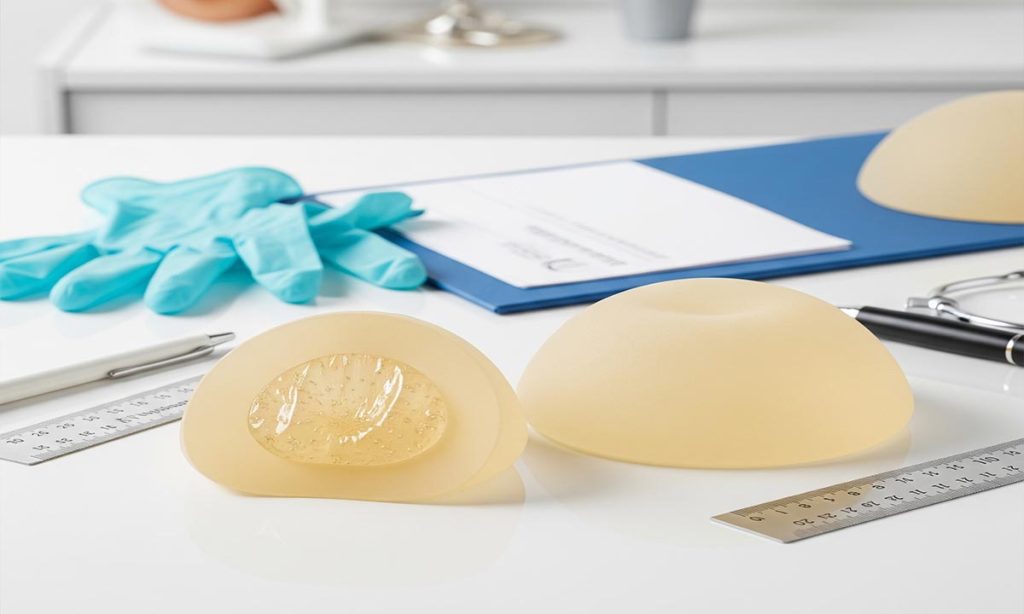Gummy bear implants (also spelled gummi bear implants) are a modern type of breast implant used in breast augmentation. They consist of a silicone outer shell filled with a highly cohesive silicone gel. This thick, gummy-like gel allows the implant to retain its teardrop shape even if cut or ruptured. The result is a very natural feel and form that mimics breast tissue. In this comprehensive guide, we’ll explore what gummy bear breast implants are, how they differ from traditional silicone or saline implants, and cover their advantages, drawbacks, typical cost, and important precautions. Our goal is to give you the full picture – from pros and cons to FAQs – so you can make an informed decision about gummy bear implants.

What Are Gummy Bear Implants?
Gummy bear breast implants are a type of form-stable or cohesive gel silicone implant. They were popularized in the mid-2000s by plastic surgeons looking for a more natural-looking augmentation option. Dr. Grant Stevens, a leading plastic surgeon, coined the term “gummy bear” because these implants maintain their shape when cut, much like a gummy candy. Technically, gummy bears are filled with a denser silicone gel that is highly cross-linked – this gel sticks to itself so tightly that it does not easily leak or spread. The shells are often textured to keep the implants in place and reduce complications.
Plastic surgeon holding a gummy bear silicone breast implant. Gummy bear implants are highly cohesive gel implants that hold their teardrop shape even if the outer shell breaks. This gives them a natural contour and feel, as seen above. Unlike saline implants (filled with sterile salt water) or older silicone implants (with softer gel), gummy bears use a firmer gel that resists deformation. In fact, some plastic surgeons now use “gummy bear” broadly to mean any highly cohesive silicone implant. However, originally the term specifically referred to anatomical (tear-drop) shaped cohesive gel implants.
Key characteristics of gummy bear implants include:
- Shape Stability: The cohesive gel maintains shape even if cut or ruptured.
- Teardrop Contour: Most gummy bears are available in anatomical (teardrop) shapes to mimic natural breast contours.
- Textured Shell: To prevent rotation, these implants often have a textured surface that lets tissue “grab” onto the implant (like Velcro).
- High Cohesivity: The thick silicone gel has more cross-linking, making it firmer than traditional silicone implants.
All gummy bear implants are essentially silicone implants – the main difference is the consistency of the gel and the shape. Traditional round silicone implants use softer, more liquid gel, whereas gummy bears use a gel as firm as a solid candy. This form-stable quality led to the “gummy bear” nickname.
Pros of Gummy Bear Implants
Gummy bear implants offer several distinct advantages over other implant types. Their design and material lead to:
- Natural Look and Feel: The highly cohesive gel and teardrop shape closely mimic natural breast tissue. Many patients find it hard to tell they’re artificial because gummy bears maintain a soft fullness, especially in the lower pole of the breast, with less unnatural roundness on top.
- Shape Retention: They hold their shape even if the shell is damaged. In practical terms, this means less risk of deflation or significant shape change. Saline implants collapse if ruptured, but a gummy bear implant’s gel stays in place.
- Durability: The thicker gel is stronger and less prone to leaking than traditional silicone or saline. This translates to a lower rupture rate. When a gummy bear implant does crack, the silicone tends to stay within the implant rather than migrating into the body.
- Softness to Touch: Despite being form-stable, gummy bears often feel very natural and soft to the patient and partner. Patients report that cohesive gel implants have a more lifelike feel compared to older implants.
- Less Rippling: Because the gel is firm and fully fills the shell, gummy bear implants show fewer surface wrinkles or ripples under the skin. This is especially beneficial for women with thin breast tissue.
- Reduced Capsular Contracture (Scar Tissue): Many gummy bear implants have textured shells that allow tissue integration. Studies show textured (or anatomically shaped) implants have a lower rate of capsular contracture (tight or hard scar tissue around the implant) than smooth implants. Thus gummy bears may reduce the chance of this common complication.
In summary, gummy bear implants are highly regarded for their aesthetic results and strength. They excel at creating a natural appearance and are generally more durable than older implant technologies. For women seeking a longer-lasting, natural-feeling augmentation, these are major pros.
Cons of Gummy Bear Implants
No implant is perfect, and gummy bear implants also have drawbacks to consider:
- Higher Cost: These implants and the surgery cost significantly more than saline or simple silicone options. Estimates range from $6,000 to $12,000 for a procedure with gummy bear implants. (By comparison, the ASPS quoted an average of about $3,700 for breast augmentation in 2017.) The advanced materials and surgeon’s expertise needed contribute to this price.
- Larger Incision: Because gummy bear implants cannot be folded or filled in place, surgeons must make a slightly larger incision to insert the implant intact. (Saline implants can be inserted empty and then filled through a smaller cut.) In practice, this means a longer scar than with saline implants.
- Rotation Risk: Most gummy bear implants are teardrop-shaped. If such an implant rotates out of alignment, the breasts will look uneven or distorted, since the implant isn’t symmetrical on all sides. Correction requires a revision surgery. (To minimize this, gummy bears are textured to “stick” in place.)
- Not Ideal for Sagging Breasts: Gummy bear implants add volume but do not lift sagging or drooping breasts. Women whose main issue is breast ptosis may need a mastopexy (breast lift) instead or in addition, as implants alone won’t reshape loose skin.
- Harder Leak Detection: If a gummy bear implant ruptures, the cohesive gel may stay mostly in the shell or in the pocket. This silent rupture can go unnoticed for a long time. By contrast, a saline leak is obvious immediately. Thus, doctors recommend regular MRI or ultrasound screenings to ensure gummy bear implants are intact.
- Future Replacement Likely: Like all implants, gummy bears are not lifetime devices. They generally need to be replaced or removed after about 10–15 years. Longer implant times carry higher complication risks (infections, deformation, etc.). Some sources note 20–25% of implants are removed or replaced within 10 years. Patients should plan for eventual revision surgery.
- Firmness for Some: The very cohesion that makes gummy bears durable also means they are a bit firmer than round silicone implants. Younger women with very perky, non-sagging breasts often prefer gummy bears. However, older women or those with looser skin may find them a bit stiff or less natural in feel. In other words, while they feel natural to most, some may prefer the softer consistency of traditional silicone.
- Limited FDA Approval: U.S. FDA rules restrict gummy bear implants to women age 22 or older (the same as other silicone implants). Also, since they’re textured in most cases, women should understand texture-related risks (see safety section).
These cons mean gummy bear implants aren’t for everyone. High cost, surgical technique requirements, and follow-up testing (e.g. MRI scans) are real considerations. Patients must weigh whether the aesthetic benefits justify these downsides.
Gummy Bear vs. Other Implants
It helps to compare gummy bears with other options:
- Gummy Bear vs. Traditional Silicone Implants: Both use a silicone outer shell, but gummy bears use a firmer, highly cohesive gel. Traditional round silicone implants use a softer gel that can ripple and can leak more easily. Gummy bears hold shape much better, reducing rippling, but they may feel slightly firmer. In modern practice, many leading implant manufacturers offer multiple grades of silicone cohesiveness. Some newer round implants are now highly cohesive too (sometimes also nicknamed “gummy”), blurring the lines. In general, gummy bears are the most form-stable silicone option, while standard silicone implants trade some shape stability for a softer consistency.
- Gummy Bear vs. Saline Implants: Saline implants are filled with sterile saltwater and are the least expensive option. They allow smaller incisions (filled after insertion), but rippling and a “sloshy” feel are more common with saline. Gummy bears give a much more natural feel and minimize visible ripples, at the cost of price. Importantly, a ruptured saline implant causes the breast to visibly deflate, while a gummy bear’s gel stays put. However, saline implants do not carry any risk of silicone-related immune reactions, whereas gummy bear implants do (since they’re silicone-based).
- Comparison Summary: In bullet form, comparing breast implant types:
- Saline: Lowest cost; smaller incision; can ripples; feels the least natural.
- Traditional Silicone (Soft Gel): Moderate cost; natural feel; possible rippling; risk of silent leak.
- Gummy Bear (Highly Cohesive Silicone): Highest cost; longest incision; very natural look; minimal rippling; very low rupture risk; requires textured shell (see ALCL risk below).
The choice depends on priorities: budget vs. aesthetic goals vs. tolerance for frequent check-ups. Many women choose gummy bear implants for a natural droop and feel, even though they pay more and need careful follow-up.
Gummy Bear Implants Cost
Breast augmentation costs vary widely, but gummy bear implants are generally more expensive than other augmentation procedures. Costs depend on the surgeon’s fee, facility fees, anesthesia, geographic location, and implant type. Here are some typical figures:
- Procedure Cost Range: Studies and clinics report a wide range around $6,000 to $12,000 for breast augmentation with gummy bear implants. One clinic notes an average breast augmentation (any implant) was about $3,700 in 2017, whereas gummy bear cases tend to exceed $6,000.
- Silicone Premium: Silicone (including gummy bear) implants often cost about $1,000 more than saline implants. That accounts for part of the higher total.
- Additional Expenses: Remember to include related costs: operating room fees, anesthesia fees, surgical garments, prescribed medications, and any imaging (e.g. pre-op MRI may be needed).
- Insurance: Cosmetic breast augmentation is usually not covered by insurance unless it’s medically necessary (e.g. reconstruction). Expect to pay out-of-pocket.
To get an exact quote, consult a board-certified plastic surgeon. They will break down costs by item. For budgeting, use the above ranges as a guideline. Financing may be available through medical lenders or credit programs.
Precautions and Safety
Gummy bear implants require the same careful consideration as any breast implants, plus a few specific safety points:
- Age and Pregnancy: The FDA approves silicone implants (including gummy bears) only for patients 22 years or older. Women who are pregnant or breastfeeding should wait to have implants. Surgery during pregnancy carries risks, so surgeons universally advise against it.
- Stable Weight: Significant weight gain or loss can dramatically change breast size and shape. It’s best to reach a stable, healthy weight before augmentation. Losing or gaining a lot after getting implants can distort the results.
- Breast Shape/Sagging: If your breasts have significant sag (ptosis), implants alone won’t lift them. In such cases, a surgeon may recommend combining a breast lift (mastopexy) with implants, or doing a lift alone. Do not rely on implants to correct severe sagging.
- Medical Conditions: Discuss any autoimmune or connective tissue conditions with your doctor. While evidence is inconclusive, some studies note that women with autoimmune issues might be more cautious with implants.
- Follow-up Screening: Because gummy bear implants have a risk of silent rupture, FDA guidelines recommend getting an MRI 3 years after implantation and every 2 years after that. These imaging checks help ensure the implants remain intact.
- Record Implant Details: Always keep records of the implant’s brand, style, and serial number. If any future recall or alert happens, you’ll know if you’re affected. (For example, Allergan later recalled certain textured implants.)
- Watch for Symptoms: Pay attention to breast changes. Swelling, pain, lumps, or changes in size/shape should prompt medical attention. The FDA found an association between textured implants and a rare lymphoma called BIA-ALCL. Although the overall risk is low, it occurs more often with textured implants (which includes most gummy bears). In 2019, Allergan voluntarily recalled its textured Natrelle BIOCELL implants (including the anatomical 410 “gummy bear” style) because of this risk. The American Cancer Society notes that if you have these specific textured implants, you should talk to your surgeon.
- Regular Check-ups: Continue routine health checks. During annual exams, let the provider know you have breast implants. They can check for skin changes or masses. Also follow your plastic surgeon’s aftercare schedule.
- Consult Experts: Choose a board-certified plastic surgeon experienced in gummy bear implants. They will advise you on candidacy and take appropriate precautions. Do not undergo surgery with an inexperienced provider.
By following these precautions—pre-surgery screening, selecting the right candidate, and diligent follow-up—you can minimize risks. In summary, gummy bear implants require standard implant vigilance: regular monitoring and surgeon communication are essential.
Frequently Asked Questions (FAQs)
Q: What exactly is a gummy bear breast implant?
A: It’s a breast implant with a very thick silicone gel filler. Unlike older implants, its gel is highly cohesive – meaning it sticks together. This is why if you cut the implant, it holds its shape like a gummy candy. The result is a natural-looking, teardrop shape that mimics breast tissue.
Q: How do gummy bear implants differ from regular silicone or saline implants?
A: All gummy bears are silicone implants (with silicone shell and gel). The difference is in the gel’s firmness and implant shape. Traditional silicone implants have a softer, liquid gel and are usually round. Saline implants use saltwater and require filling after insertion. Gummy bears use a stiffer, form-stable gel, which reduces wrinkling and holds shape better. They also typically come in an anatomical (teardrop) shape, whereas regular silicone can be round or teardrop.
Q: What are the main benefits of choosing gummy bear implants?
A: The key pros are natural appearance and durability. They provide a very natural breast contour and feel, with less rippling or wrinkling. They’re less likely to rupture, and even if they do, the gel stays cohesive. Textured gummy bears may also have a lower rate of capsular contracture (scar tightening). In short, they look and act more like real breast tissue than older implants.
Q: What drawbacks should I know about gummy bear implants?
A: Drawbacks include higher cost (often double saline), and the need for a slightly longer incision. The implant must be inserted whole. Also, teardrop implants can rotate, which may cause asymmetry and require revision surgery. If you have significant breast sagging, gummy bears won’t lift that. Finally, like all implants, they aren’t permanent – expect replacement surgery in about 10 years.
Q: How much do gummy bear implants cost?
A: The implants themselves and surgery typically cost $6,000–$12,000 (in the U.S.). This varies by surgeon and location. Silicone implants add about $1,000 to the cost over saline. Remember to budget for related fees (facility, anesthesia, etc.). Since breast augmentation is usually cosmetic, insurance usually won’t cover it.
Q: Are gummy bear implants safe? Are there any recalls or FDA concerns?
A: Current evidence says they are generally safe when placed by an experienced surgeon. They have been extensively studied in trials. However, no implant is risk-free. One safety issue is breast implant-associated ALCL (BIA-ALCL), a very rare lymphoma linked mostly to textured implants. In 2019, Allergan recalled certain textured gummy bear implants (Natrelle 410) due to this risk. If you have these specific implants, talk to your doctor about what to do. Also follow FDA guidelines: get regular MRI scans and exams. Consult with a surgeon about your personal risk factors.
Q: How long do gummy bear implants last?
A: There’s no guaranteed “lifetime,” but the average wearer replaces them around 10–12 years. About 20–25% of women have surgery to remove or replace implants within that time. Advances may extend longevity, but implants can scar, rupture, or change breast shape over the decades. Plan on them being a 10-year solution.
Q: What should I consider before getting gummy bear implants?
A: Make sure you’re at a stable weight, are not pregnant/nursing, and discuss any health issues with your doctor. If you already have breast sagging, you may need a lift, not just implants. Choose a board-certified plastic surgeon, ask about their experience with gummy bear implants, and view before-and-after photos of actual patients. Maintain realistic expectations and understand the commitment: you’ll need follow-up care and possibly future surgeries.
Q: What is recovery like after gummy bear implant surgery?
A: Recovery is similar to any breast augmentation. You’ll have swelling and bruising for a few weeks. Most patients return to desk work within a week, but avoid heavy lifting or intense exercise for about 6 weeks. Pain is managed with medication. Full recovery (final breast shape) can take several months. Your surgeon will give you detailed postoperative instructions.
Conclusion
Gummy bear breast implants offer a compelling option for women seeking very natural, long-lasting results in breast augmentation. Their pros – excellent shape retention, natural feel, and durability – make them highly attractive. However, they also come with cons such as higher cost, larger incisions, and the need for vigilant long-term follow-up. Safety precautions (age, screening for ALCL, etc.) are especially important given their texturing.
Ultimately, choosing gummy bear implants should be a decision made with a qualified surgeon. We’ve covered the essentials – including costs, risks, and key differences from regular implants – to help you weigh the pros and cons.
Ready to learn more or share your story? Consult a board-certified plastic surgeon for personalized advice. If you found this guide helpful, please share it on social media and leave a comment or question below!






4 thoughts on “Gummy Bear Implants: Pros and Cons, Cost, Precautions”